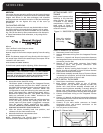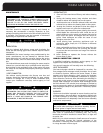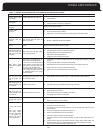
4
WARM AIR FURNACE
S
EQUENCE OF OPERATION
1. Thermostat, responding to cool room, calls for heat.
2. Combustion air blower begins.
3. After 15 second prepurge, hot surface igniter warms up.
4. After approximately 5 seconds, the gas valve will open,
and the burners ignite.
5. Thirty seconds after the burners ignite and flame sense
is proven, the main blower starts on the heating speed.
6. System remains in this state until the room air
temperature rises causing the thermostat to terminate
its call for heat.
7. The gas valve shuts off; the burners extinguish.
8. After brief postpurge period, (5 seconds), the
combustion air fan stops. The main blower continues to
run. Elapsed time ranges from 60 seconds to 180
seconds, depending on the manufacturer’s requirement.
9. The furnace remains idle until the next call for heat.
VARIATIONS
If your system includes air conditioning, your thermostat
(supplied by the installer) will likely have two switches. The
first switch is the system switch. The switch settings usually
include HEAT, COOL, and OFF. Some thermostats have system
switches which include HEAT, COOL, AUTO, and OFF. The
system switch must be in the HEAT or AUTO position for the
furnace to run.
The second switch is the fan switch. It usually has settings of
ON and AUTO. The fan switch may be in either position
when using the furnace. If the fan switch is set to ON, the
main blower will run continuously, and the blower delays
mentioned in the sequence of operation points 5 and 9 will
be ignored.
CAUTION
THE FURNACE SHOULD BE OPERATED WITH ALL PANELS IN
PLACE. NEVER OPERATE THE FURNACE WITH THE BLOWER
D
OOR REMOVED EXCEPT FOR SERVICE PURPOSES.
WARNING
ALWAYS DISCONNECT THE ELECTRICAL SUPPLY TO THE
FURNACE BEFORE REMOVING THE BURNER
C
OMPARTMENT ACCESS DOOR.
The furnace achieves its mid-efficiency in two general areas.
First, there is no wasteful standing pilot. The furnace
consumes no gas in between cycles. Secondly, the furnace is
designed to allow very small amounts of excess air in the
combustion process. Older furnaces had heat exchangers
that were commonly 40% larger than necessary for
complete combustion. While this prevented the creation of
carbon monoxide, the heated excess air was expelled up the
chimney where it could not benefit the interior of the
home. Special safety controls now prevent the formation of
carbon monoxide.
IMPORTANT
Your furnace should be cleaned and inspected annually by a
trained and qualified service technician.
Your service technician has the knowledge and test
equipment to determine the condition of your furnace.
WARNING
THE EXHAUST GASES FROM THIS FURNACE CONTAIN
CHEMICALS, WHICH ON SOME OCCASIONS MAY
INCLUDE CARBON MONOXIDE (CO). CARBON
MONOXIDE IS AN ODORLESS, TASTELESS, CLEAR
COLORLESS GAS, WHICH IS HIGHLY TOXIC. EVEN LOW
CONCENTRATIONS ARE SUSPECTED OF CAUSING BIRTH
DEFECTS AND OTHER REPRODUCTIVE HARM.
UL AND CUL RECOGNIZED CO DETECTORS ARE
RECOMMENDED FOR ALL BUILDINGS EQUIPPED WITH
FOSSIL FUEL BURNING APPLIANCES. ALL CO DETECTORS
SHOULD BE INSTALLED IN ACCORDANCE WITH THEIR
MANUF
ACTURER’S INSTRUCTIONS AND APPLICABLE
LOCAL BUILDING CODES.


















